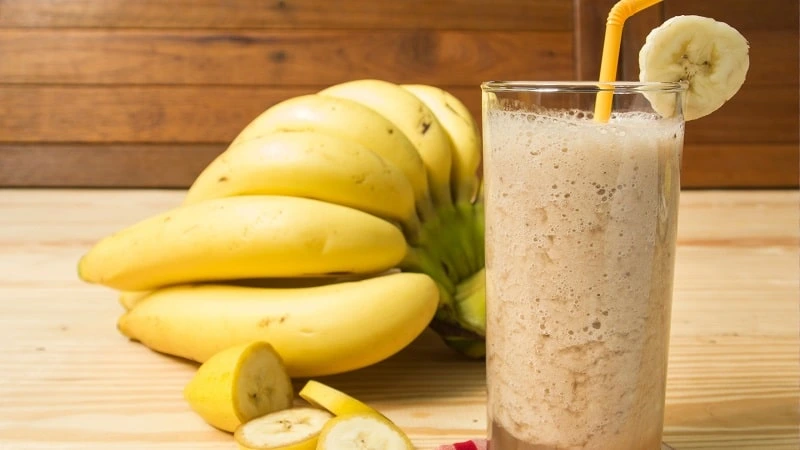Bananas are a common and beloved fruit, often enjoyed as a quick snack or added to meals. Recently, there’s been a rise in blending bananas to create smoothies and other tasty treats. But have you ever wondered Does Blending a Banana Make it Unhealthy?
Exploring whether blending affects the goodness of bananas is crucial for those looking to make the most of their diets. By understanding if blending a banana makes it unhealthy, you can continue to enjoy this fruit in a way that supports your well-being. Let’s dive into the world of blended bananas to uncover the facts behind their nutritional value.
Nutritional Benefits of Bananas
Bananas are more than just a tasty treat; they pack a nutritional punch that can contribute to your overall well-being. Let’s explore the specific benefits that make bananas a popular choice for health-conscious individuals.
Rich in Potassium
Potassium, a vital mineral, is abundantly found in bananas. This mineral plays a role in maintaining proper heart function, regulating blood pressure, and supporting muscle contractions. Including bananas in your diet can help ensure a healthy balance of potassium in your body.

Read More: What Contaminant Poses the Greatest Foodborne Illness Risk?
Dietary Fiber for Digestion and Satiety
Bananas are a good source of dietary fiber. This fiber aids in digestion by promoting regular bowel movements and preventing constipation.
Additionally, fiber helps you feel full and satisfied after eating, which can be beneficial for managing your appetite.
Essential Vitamins and Minerals
Bananas are not only rich in potassium but also contain essential vitamins and minerals. These include vitamin C, which supports your immune system, and vitamin B6, important for brain development and function.
Furthermore, bananas provide small amounts of other essential nutrients like magnesium and vitamin A.
Does Blending a Banana Make it Unhealthy?
Blending bananas is a popular method to create creamy, flavorful concoctions. Let’s delve into the process of blending and understand how it affects the nutritional aspects of this fruit.
Explanation of Blending
Blending involves using a machine, like a blender or food processor, to mix foods into a smooth and consistent texture.
When you blend a banana, it’s transformed from its natural solid form into a creamy liquid, often used as a base for smoothies, shakes, or desserts.
Effects on Nutritional Content
The blending process breaks down the cell walls of the banana, making its nutrients more accessible.
This means that the nutrients can be absorbed by your body more easily. While the structure of the banana changes, the essential vitamins, minerals, and dietary fiber remain present.
Read Also: What is Tonsillitis Food to Avoid?
Impact of Oxidation
During blending, the banana is exposed to air, leading to oxidation. Oxidation is a natural chemical process that can cause slight nutrient loss, particularly of vitamin C.
To minimize nutrient loss due to oxidation, it’s a good practice to consume your blended banana creation soon after preparing it.
Potential Concerns about Blended Bananas
While blending bananas offers convenience and a unique taste experience, there are a few aspects to consider when it comes to their impact on your health. Let’s explore these potential concerns in detail.

Quick Increase in Sugar Release
Blending bananas can lead to a faster release of sugars into your bloodstream compared to eating them whole.
This quick surge in sugar levels might impact individuals with diabetes or those looking to manage their blood sugar.
It’s advisable to be mindful of the overall sugar content in your blended creations and consider adding ingredients that slow down sugar absorption, like healthy fats or proteins.
Reduced Fiber Content and Its Implications
The blending process can break down the dietary fiber present in bananas, especially the insoluble fiber that contributes to feelings of fullness and supports healthy digestion.
Reduced fiber content might lead to less sustained satiety, potentially causing you to consume more calories overall.
To address this, you can consider incorporating other high-fiber ingredients into your blend or consuming whole fruits alongside blended creations.
Influence on Feeling Full and Portion Control
Whole bananas require chewing, which sends signals to your brain that you’re eating. Blending bypasses this chewing process, and you might not feel as full as quickly as you would with whole fruit.
This could lead to overconsumption if you’re not attentive to portion sizes. Being mindful of how much you consume and listening to your body’s cues is crucial when enjoying blended banana-based meals.
Read Also: Cinnamon Toast Crunch Protein Powder
Making the Most of Blended Bananas
Blending bananas can be a delicious and nutritious addition to your diet when approached mindfully. Let’s explore how you can optimize the health benefits of blended bananas by making thoughtful choices.
Incorporating Other Ingredients for Balance
Enhance the nutritional profile of your blended banana creations by adding a variety of ingredients.
Consider tossing in some leafy greens like spinach or kale for added vitamins and minerals. You can also include sources of protein, such as Greek yogurt or nut butter, to make your blend more satisfying and supportive of muscle health.
Adding Sources of Healthy Fats
Including healthy fats in your blended creations can help slow down the absorption of sugars and contribute to longer-lasting satiety.
Avocado, chia seeds, or a drizzle of olive oil are great options to consider. These fats not only enhance the texture but also provide essential fatty acids that support overall well-being.
Being Mindful of Overall Diet and Consumption
While blended bananas offer a convenient way to enjoy this fruit, it’s important to view them as part of your overall diet.
Ensure that your diet is well-balanced, incorporating a variety of nutrient-rich foods. Also, pay attention to portion sizes when enjoying blended banana treats to avoid overindulgence and maintain a healthy caloric intake.
Conclusion
In the world of nutrition, the practice of blending bananas introduces a convenient way to enjoy their goodness.
While blending may alter the texture and possibly lead to minor nutrient loss due to oxidation, the core nutritional benefits of bananas—like potassium, dietary fiber, and essential vitamins—remain preserved.
By thoughtfully considering the potential concerns, such as quicker sugar release and reduced fiber content, and addressing them with strategies like incorporating additional ingredients and practicing portion control, you can derive the most benefit from blended bananas.
Remember, the key lies in balance and moderation. Blended bananas can undoubtedly be a tasty and nutritious addition to your diet, contributing to your overall well-being when integrated wisely. As you explore the world of blended fruits, keep in mind the broader context of your diet and health goals.
FAQs about Blending Bananas
1. Are blended bananas still nutritious?
Blending bananas may cause minimal nutrient loss due to oxidation, but the core nutritional value remains largely intact.
2. Does blending affect the fiber content of bananas?
Blending can break down some of the dietary fiber, particularly insoluble fiber. This might impact feelings of fullness and digestion.
3. Can blended bananas lead to a quick spike in sugar levels?
Yes, blending can accelerate the release of sugars into the bloodstream, potentially affecting individuals with diabetes or those managing blood sugar.
4. How can I manage the sugar release from blended bananas?
Adding sources of healthy fats and proteins, like nut butter or yogurt, can help slow down sugar absorption and promote satiety.
5. Can I blend bananas with other fruits or vegetables?
Absolutely, blending with nutrient-rich ingredients like leafy greens or other fruits can enhance the overall nutritional profile of your blend.
6. Does oxidation during blending impact nutrients?
Oxidation can lead to slight nutrient loss, particularly vitamin C. Consume your blends soon after preparation to minimize this effect.
7. Can blended bananas replace whole bananas in my diet?
While blended bananas offer convenience, it’s still beneficial to consume whole fruits to benefit from their natural chewing process and fiber content.
8. How can I prevent overconsumption of blended banana treats?
Practice portion control and be attentive to your body’s cues for fullness to avoid overindulgence.
9. Are there any risks associated with blending bananas?
Blending bananas is generally safe; however, if you have allergies or sensitivities to certain ingredients, be cautious when incorporating them into your blends.
Medical References
- Smith, J. M., & Campbell, W. W. (2014). Comparable effects of sugar and high-amylose cornstarch meals on postprandial incretin hormone release, appetite, and subsequent ad libitum energy intake in healthy young men. Nutrition Journal, 13(1), 36.
- Uribarri, J., Woodruff, S., Goodman, S., Cai, W., Chen, X., Pyzik, R., … & Vlassara, H. (2010). Advanced glycation end products in foods and a practical guide to their reduction in the diet. Journal of the American Dietetic Association, 110(6), 911-916.
- Dreher, M. L., & Davenport, A. J. (2013). Hass avocado composition and potential health effects. Critical Reviews in Food Science and Nutrition, 53(7), 738-750.
- Jenkins, D. J. A., Wolever, T. M. S., Taylor, R. H., Barker, H., Fielden, H., Baldwin, J. M., … & Goff, D. V. (1981). Glycemic index of foods: A physiological basis for carbohydrate exchange. The American Journal of Clinical Nutrition, 34(3), 362-366.
- Fernandes, G., Velangi, A., & Wolever, T. M. (2005). Glycemic index of foods: a physiological basis for carbohydrate exchange. The American Journal of Clinical Nutrition, 76(1), 5-56.
- Slavin, J. L. (2005). Dietary fiber and body weight. Nutrition, 21(3), 411-418.



